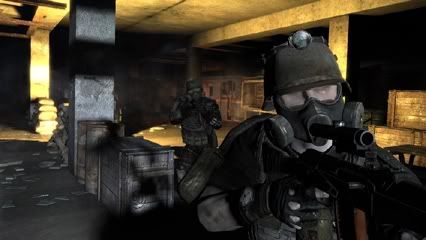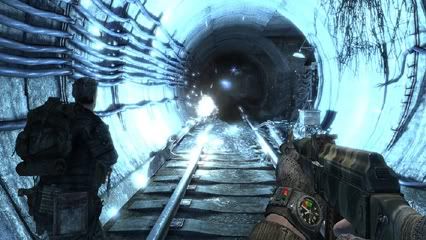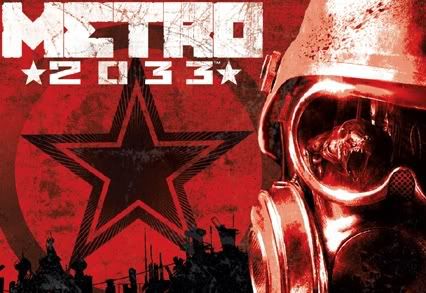- Format: Xbox 360 (version reviewed), PC
- Unleashed: Out Now
- Publisher: THQ
- Developer: 4A Games
- Players: 1
- Site: http://www.metro2033game.com/
Between Metro 2033 and the S.T.A.L.K.E.R. Series (both based, to varying degrees, on works of film and literature), a sort of Russian myth has emerged. These works describe a post-industrial wasteland where monsters and ghostly anomalies are a constant threat. It’s a hell of man’s own design – a world of hardship borne out of past indiscretions such as war or nuclear disaster. There’s a palpable sense of allegory to these stories and settings – they’re a reflection of a culture still affected by events like the Cold War and Chernobyl. It’s a culture that’s been relatively ignored in the game space (or overused as cannon fodder in Western games), and it’s this foreign aesthetic and design philosophy that makes Metro 2033 stand out from your average first-person shooter.
You play as Artyom, a young man living in the dwindling safety of Moscow’s underground metro. It’s been 20 years since the surface was destroyed by nuclear armageddon. People live in a constant state of survival and fear, fighting among themselves when they aren’t being assailed by mutants known as “dark ones”. Metro 2033 paints a dark and oppressive world, where bullets are a form of currency and even Nazis see fit to make a comeback.
Artyom’s journey begins when he’s asked to deliver a message to a far-off outpost known as Polis. Along his journey he meets his fair share of interesting characters, small bustling communities, and peril at nearly every turn. The game tells a linear tale, scripted in a style reminiscent of Half-Life 2.
All told, the 8-10 hour plot never really amounts to much. Characters come and go, and you may often find yourself wondering what you’re supposed to do next. Despite being based on a novel, Artyom’s tale is not as rich as you’d expect. Instead, it’s the personal journey you take through these miserable and evocative environments that makes Metro 2033 a worthwhile experience. In spite of some embarrassing AI (soldiers run from cover to cover like chickens with their heads cut off), Metro 2033 stands alongside games like Bioshock, Fallout 3, and Far Cry 2 in how it crafts an immersive, rich world. Each metro station is claustrophobic with detail, packed with a stunning amount of people talking, selling goods, begging for bullets, and drinking vodka. Between stations, the dangerous tunnels and harsh conditions on the surface force you to constantly monitor your vitals and equipment.
In spite of some embarrassing AI (soldiers run from cover to cover like chickens with their heads cut off), Metro 2033 stands alongside games like Bioshock, Fallout 3, and Far Cry 2 in how it crafts an immersive, rich world. Each metro station is claustrophobic with detail, packed with a stunning amount of people talking, selling goods, begging for bullets, and drinking vodka. Between stations, the dangerous tunnels and harsh conditions on the surface force you to constantly monitor your vitals and equipment.
You’ll often have to pass through noxious gases, requiring a gas mask and a supply of fresh air-filters. Darkness requires a flashlight or night-vision goggles, each in turn draining a battery you must stop to pump manually. HUD elements are kept to a minimum – almost everything has a physical representation, whether you’re charging your battery, checking your journal with a lighter, or swapping out a cracked gas mask. The threat of suffocation, of being lost in darkness, or simply huddling in a corner with your journal and lighter add significantly to the oppressive mood.
Being careful and thorough will get you through almost any situation, but there’s always this nagging feeling that you could become irreparably stuck in a scenario. There will be a moment at some point in your journey where you’ll be down to your last few air filters, left to nervously scramble to the next safe area. And while you can always restart at the beginning of a chapter, the threat of harsh punishment for your mistakes remains. Metro 2033 is unafraid to throw seemingly unfair scenarios your way. There are areas absolutely teeming with enemies. They usually begin as stealth missions before devolving into desperate fire-fights. If not for the weak AI, these sections would probably be the best parts of the game. As they stand, it’s not worth sneaking around when one false move will alert an entire level’s worth of soldiers.
Metro 2033 is unafraid to throw seemingly unfair scenarios your way. There are areas absolutely teeming with enemies. They usually begin as stealth missions before devolving into desperate fire-fights. If not for the weak AI, these sections would probably be the best parts of the game. As they stand, it’s not worth sneaking around when one false move will alert an entire level’s worth of soldiers.
The game falls short of instant classic thanks to some genuinely annoying flaws. The aforementioned poor AI carries over to all but one of the game’s monsters (you’ll know it when you see it), with the rest of them running straight at you and mindlessly clawing at your flesh. It’s not that monsters wouldn’t do that, but the developers failed to make these scenarios play out in a believable way. Each monster attack looks like a wild mosh-pit of enemies and friendlies rather than something truly life-threatening. But that doesn’t hurt the immersion quite as much as the identity crisis the game has as the story plays out. Metro 2033 can’t decide whether it wants to tell a first-person or third-person narrative, often unnecessarily pulling the camera out and completely killing the tension. It also can’t decide whether Artyom is a silent protagonist or not, abusing this tired story-telling mechanic with a character who has a voice but doesn’t use it.
But that doesn’t hurt the immersion quite as much as the identity crisis the game has as the story plays out. Metro 2033 can’t decide whether it wants to tell a first-person or third-person narrative, often unnecessarily pulling the camera out and completely killing the tension. It also can’t decide whether Artyom is a silent protagonist or not, abusing this tired story-telling mechanic with a character who has a voice but doesn’t use it.
Thankfully, these moments are minimal. Metro 2033 maintains a solid suspension of disbelief that keeps the journey absorbing to the end. Whether you should take the ride depends greatly on your interest in scripted, linear, single-player games. There’s no online multiplayer, just a solemn and personal experience with a Russian flair you won’t soon forget.
8/10


















Comments